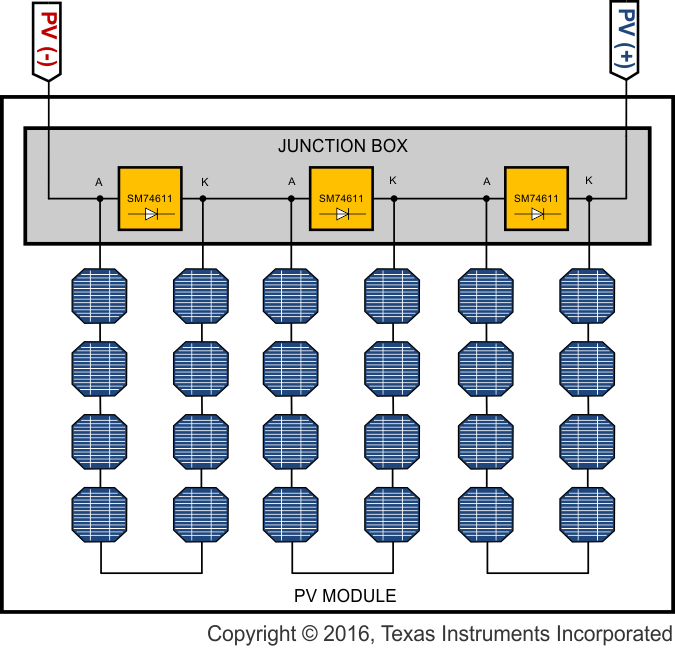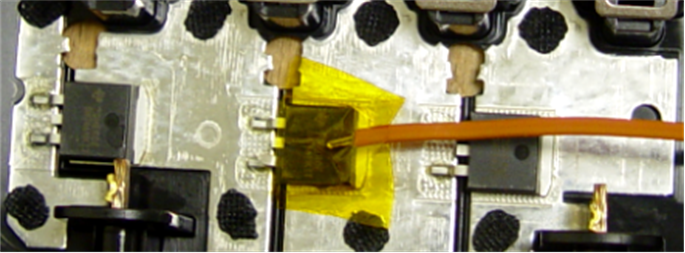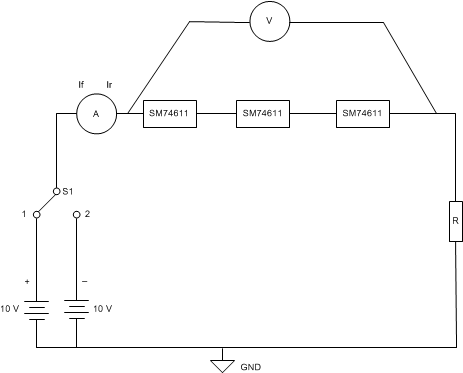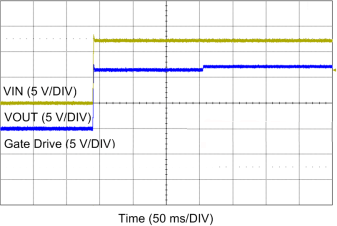-
SM74611 Smart Bypass Diode
- 1 Features
- 2 Applications
- 3 Description
- 4 Revision History
- 5 Pin Configuration and Functions
- 6 Specifications
- 7 Detailed Description
- 8 Application and Implementation
- 9 Power Supply Recommendations
- 10Layout
- 11Device and Documentation Support
- 12Mechanical, Packaging, and Orderable Information
- IMPORTANT NOTICE
Package Options
Mechanical Data (Package|Pins)
- KTT|3
Thermal pad, mechanical data (Package|Pins)
Orderable Information
SM74611 Smart Bypass Diode
1 Features
- Maximum Reverse Voltage (VR) of 30 V
- Operating Forward Current (IF) of up to 15 A
- Low Average Forward Voltage (26 mV at 8 A)
- Less Power Dissipation than Schottky Diode
- Lower Leakage Current than Schottky Diode
- Footprint and Pin-Compatible With Conventional D2PAK Schottky Diode
- Operating Range (TJ) of –40°C to 125°C
2 Applications
- Bypass Diodes for Photovoltaic Panels
- Bypass Diodes for Microinverter and Power Optimizer
3 Description
The SM74611 device is a smart bypass diode used in photovoltaic applications. The SM74611 device serves the purpose of providing an alternate path for string current when parts of the panel are shaded during normal operation. Without bypass diodes, the shaded cells will exhibit a hot spot which is caused by excessive power dissipation in the reverse biased cells.
Currently, conventional P-N junction diodes or Schottky diodes are used to mitigate this issue. Unfortunately the forward voltage drop for these diodes is still considered high (approximately 0.6 V for normal diodes and 0.4 V for Schottky). With 10 A of currents flowing through these diodes, the power dissipation can reach as high as 6 W. This in turn will raise the temperature inside the junction box where these diodes normally reside and reduce module reliability.
The advantage of the SM74611 is that it has a lower forward voltage drop than P-N junction and Schottky diodes. It has a typical average forward voltage drop of 26 mV at 8 A of current. This translates into typical power dissipation of 208 mW, which is significantly lower than the 3.2 W of conventional Schottky diodes. The SM74611 is also footprint and pin compatible with conventional D2PAK Schottky diodes, making it a drop-in replacement in many applications.
Device Information(1)
| PART NUMBER | PACKAGE | BODY SIZE (NOM) |
|---|---|---|
| SM74611 | TO-263 (3) | 10.18 mm × 8.41 mm |
- For all available packages, see the orderable addendum at the end of the datasheet.
Typical Application in a Junction Box

4 Revision History
Changes from A Revision (November 2014) to B Revision
- Added Device Functional Modes, Application and Implementation section, Power Supply Recommendations section, Layout section, Device and Documentation Support section, and Mechanical, Packaging, and Orderable Information section Go
Changes from * Revision (December 2012) to A Revision
5 Pin Configuration and Functions

Pin Functions
| PIN | I/O | DESCRIPTION | |
|---|---|---|---|
| NAME | NO. | ||
| ANODE | 1(1) | I | Connect both of these pins to the negative side of the PV cells |
| 3(1) | |||
| CATHODE | 2(2) | O | Pin 2 and the DAP are shorted internally. Connect the DAP to the positive side of the PV cells |
| DAP(2) | |||
6 Specifications
6.1 Absolute Maximum Ratings
over operating free-air temperature range (unless otherwise noted)(1)(2)| MIN | MAX | UNIT | |
|---|---|---|---|
| DC reverse voltage | 30 | V | |
| Forward current | 24 | A | |
| Junction temperature, t ≤ 1 hour | 135 | °C | |
| Storage temperature, Tstg | –65 | 125 | °C |
6.2 ESD Ratings
| VALUE | UNIT | |||
|---|---|---|---|---|
| V(ESD) | Electrostatic discharge | Human-body model (HBM), per ANSI/ESDA/JEDEC JS-001(1) | ±1000 | V |
| Charged-device model (CDM), per JEDEC specification JESD22-C101(2) | ±250 | |||
6.3 Recommended Operating Conditions
over operating free-air temperature range (unless otherwise noted)(1)| MIN | MAX | UNIT | ||
|---|---|---|---|---|
| DC reverse voltage | 28 | V | ||
| Junction temperature (TJ) | –40 | 125 | °C | |
| Forward current | 0 | 15 | A | |
6.4 Thermal Information
| THERMAL METRIC(1) | SM74611 | UNIT | |
|---|---|---|---|
| KTT (TO-263) | |||
| 3 PINS | |||
| RθJA | Junction-to-ambient thermal resistance | 40.4 | °C/W |
| RθJC(top) | Junction-to-case (top) thermal resistance | 42.6 | °C/W |
| RθJB | Junction-to-board thermal resistance | 23.0 | °C/W |
| ψJT | Junction-to-top characterization parameter | 9.8 | °C/W |
| ψJB | Junction-to-board characterization parameter | 22.0 | °C/W |
| RθJC(bot) | Junction-to-case (bottom) thermal resistance | 0.5 | °C/W |
6.5 Electrical Characteristics
| PARAMETER | TEST CONDITIONS | MIN | TYP | MAX | UNIT | ||||
|---|---|---|---|---|---|---|---|---|---|
| IF(AVG) | Forward current | 8 | 15 | A | |||||
| VF(AVG) | Forward voltage | IF = 8 A | TJ = 25°C | 26 | mV | ||||
| PD | Power dissipation | IF = 8 A | TJ = 25°C | 208 | mW | ||||
| TJ = 125°C | 450 | ||||||||
| –40°C to 125°C(1) | 575 | ||||||||
| IF = 15 A | TJ = 25°C | 695 | |||||||
| TJ = 125°C | 1389 | ||||||||
| D | Duty cycle | IF = 8 A | TJ = 25°C | 99.5% | |||||
| TJ = 125°C | 96.0% | ||||||||
| IR | Reverse leakage current | VREVERSE = 28 V | TJ = 25°C | 0.3 | µA | ||||
| TJ = 125°C | 3.3 | ||||||||
7 Detailed Description
7.1 Overview
The SM74611 is designed for use as a bypass diode in photovoltaic modules. The SM74611 uses a charge pump to drive an N-channel FET to provide a resistive path for the bypass current to flow.
7.2 Functional Block Diagram

7.3 Feature Description
The operational description is described in the following sections. See Figure 4 and Figure 5.
7.3.1 From t0 to t1
When cells in the solar panels are shaded, the FET Q1 is off and the bypass current flows through the body diode of the FET as shown on Figure 4. This current produces a voltage drop (VF) across ANODE and CATHODE terminal of the bypass diode. During this time, the charge pump circuitry is active and charging capacitor C1 to a higher voltage.
7.3.2 At t1
Once the voltage on the capacitor reaches its predetermined voltage level, the charge pump is disabled and the capacitor voltage is used to drive the FET through the FET driver stage.
7.3.3 From t1 to t2
When the FET is active, it provides a low resistive path for the bypass current to flow thus minimizing the power dissipation across ANODE and CATHODE. Because the FET is active, the voltage across the ANODE and CATHODE is too low to operate the charge pump. During this time, the stored charge on C1 is used to supply the controller as well as drive the FET.
7.3.4 At t2
When the voltage on the capacitor C1 reaches its predetermined lower level, the FET driver shuts off the FET. The bypass current will then begin to flow through the body diode of the FET, causing the FET body diode voltage drop of approximately 0.6 V to appear across ANODE and CATHODE. The charge pump circuitry is re-activated and begins charging the capacitor C1. This cycle repeats until the shade on the panel is removed and the string current begins to flow through the PV cells instead of the body diode of the FET.
The key factor to minimizing the power dissipation on the device is to keep the FET on at a high duty cycle. The average forward voltage drop will then be reduced to a much lower voltage than for a Schottky or regular P-N junction diode.
 Figure 5. ANODE to CATHODE Voltage (Ch1) With IBYPASS = 15 A (Ch4) for SM74611 in Junction Box at 85˚C Ambient
Figure 5. ANODE to CATHODE Voltage (Ch1) With IBYPASS = 15 A (Ch4) for SM74611 in Junction Box at 85˚C Ambient
7.4 Device Functional Modes
7.4.1 FET Q1 OFF
Initially, the internal FET Q1 is OFF. This is between t0 and t1 as shown in Figure 5. When current begins flowing from ANODE to CATHODE, the FET Q1 body diode conducts with a voltage drop VF.
7.4.2 FET Q1 ON
The FET Q1 is ON between t1 and t2 as shown in Figure 5. During this time, the FET gate is driven and current flows through the FET through a low resistive path.
8 Application and Implementation
NOTE
Information in the following applications sections is not part of the TI component specification, and TI does not warrant its accuracy or completeness. TI’s customers are responsible for determining suitability of components for their purposes. Customers should validate and test their design implementation to confirm system functionality.
8.1 Application Information
The SM74611 smart bypass diode is a drop-in replacement for traditional bypass diodes used in photovoltaic (PV) applications. When compared to a typical diode, which has a typical 0.7-V drop during forward conduction, the SM74611 dissipates significantly less power and allows PV applications such as solar junction boxes to run much cooler.
8.2 Typical Application
The application diagram shown in Figure 6 shows 3 SM74611 Smart Bypass Diodes connected in series, each providing a bypass path for 8 solar cells for a total of 24 solar cells.
 Figure 6. Solar Junction Box
Figure 6. Solar Junction Box
8.2.1 Design Requirements
Table 1 lists the parameters for Figure 6
Table 1. Design Parameters
| PARAMETER | EXAMPLE VALUE |
|---|---|
| Minimum input voltage VINMIN | 1 V |
| Maximum input voltage VINMAX | 28 V |
| Maximum forward current IMAX | 20 A |
| Junction temperature range TJ | –40°C to 125°C |
8.2.2 Detailed Design Procedure
The SM74611 is primarily used in solar junction boxes to improve the efficiency compared to commonly used P-N junction or Schottky diodes. The junction boxes have 2 or 3 diodes in series connected across the solar panel, each diode connected across a substring of solar cells, as shown in Figure 6. Standard bodies like IEC and UL mandate certain thermal tests for bypass diodes in junction boxes. At the time of this writing, the applicable specifications include IEC61215, IEC61646, EN 50548, IEC62790, and UL3730. The test procedures across these specifications are similar and include the following:
- Apply temperature probe to the diode (in the case of SM74611 the smart bypass diode) body
- Apply 75 ± 50°C to the junction box, containing the 2 to 3 (smart bypass) diodes
- Apply panel-rated, short-circuit current through the box for 1 hour
- Increase the current to 1.25 times the rated value and continue testing for another 1 hour
While the specifications may not specify how the temperature must be maintained, it is expected that there will be no air flow as in a real application behind a solar panel. Also there may be no specification of how the temperature is raised from room to 750°C. TI recommends a gradual and controlled increase to avoid shock to the product under test. Using a good climate chamber or oven is needed to ensure uniformity and consistency of temperature during test and from test of one junction box to another. Similar precautions are also necessary with the thermocouples and temperature probes used during the tests. It is a good idea to check the equipment used with the certification body. The junction box should be operational after these tests. Due to body diode pulses, a simple diode tester cannot be used to test the Smart Bypass Diode. An example testing scheme is shown in Application Curve. To avoid component failure, the Smart Bypass Diode junction temperature must not exceed the maximum rating during these tests. See Absolute Maximum Ratings for the SM74611 limits. The junction temperature is calculated based on the measured values from the temperature probe.
The temperature probe could be applied on the top (plastic case) or bottom (tab) of the SM74611 body, as shown in Figure 7. Methods of applying this probe vary from Kapton tape, 2K-resins (for top) to soldering (bottom tab). It is good to check with the certification body regarding the acceptable method.
 Figure 7. Temperature Probe Attachment During Thermal Test
Figure 7. Temperature Probe Attachment During Thermal Test
Because the SM74611 Smart Bypass Diode cycles the FET ON and OFF to recharge the charge pump, occasionally the body diode conducts instead of the FET. Therefore the drop across the Smart Bypass Diode is not constant even at constant load. Due to this switching behavior, a normal diode tester can not be used to test the operation of the Smart Bypass Diode. The following test scheme is provided, as an example, with junction box application consideration. See Figure 8 while reading the following test steps:
 Figure 8. Example Test Setup for SM74611
Figure 8. Example Test Setup for SM74611
Step 1: Testing Forward voltage drop (set R such that If => 1 A)
- Toggle S1 to position 1
- Make sure to see If reading of 10V/R
- Measure Voltage across 3 SM74611 or 1 ea SM74611
- If the setup is working properly, Vf will be less than 150 mV (Rdson losses)
Potential Fault Conditions
- SM74611 FET is not turning ON -> the measured voltage will be > 500 mV
- SM74611 device is not soldered and open -> No If current is seen
Step 2: Testing Reverse voltage turn OFF
- Toggle S1 to position 2
- Measure current Ir which is expected to be < 1 µA
Potential Fault Conditions
- SM74611 FET is shorted or board short is present, the measured current Ir is same as If but with reverse polarity. (This is only in the case of testing each SM74611 and not applicable for testing 3 together).
8.2.3 Application Curve
 Figure 9. Start-Up Related to Input Voltage from the Panel
Figure 9. Start-Up Related to Input Voltage from the Panel


